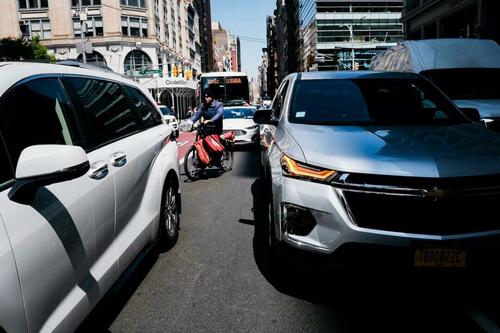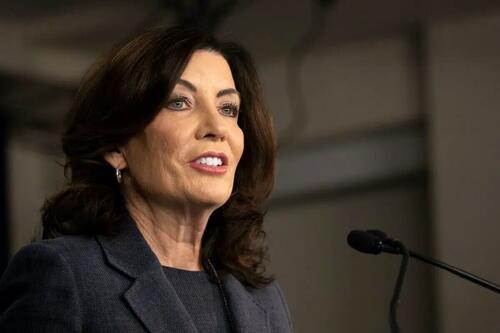Manhattan ‘Congestion Pricing’ Starts Today
Cars, SUVs, small vans, and pickup trucks entering Manhattan below 60th Street from 5am to 9pm on weekdays, and from 9am to 9pm on weekends, are going to have to pay a $9 fare for the privilege, starting on Sunday.
City officials implemented the plan, which will of course disproportionately affect low-income New Yorkers, to fund highly ambitious upgrades to the city’s aging transit systems. That said, those who make under $50,000 per year can take advantage of discounted pricing after their 10th commute in a given month.
How generous.
While the standard fare will be set at $9, the Metropolitan Transit Authority (MTA) has provided a detailed plan with pricing levels that vary based on vehicle type and time of entry. Between 9pm and 5am on weekdays and 9pm – 9am on weekends, that $9 fare drops to $2.25 for drivers of cars, SUVs, small vans and pickups – while small trucks and buses will pay $14.40 during peak hours, and $2.25 during non-peak hours.
Motorcycles will pay $4.50 during peak hours and $1.04 during non-peak times.
The fee applies to ridesharing vehicles such as Ubers as well.
Basically, it’s a shitshow – and in 2028, the fares will go up, subject to the governor’s and MTA’s approval.
The Epoch Times has more below:
Was $9 Always Envisioned?
No. The standard fare was originally set to be $15, but supporters of the scheme hit a political roadblock, as advocates for commuters argued that amount was too high for the average worker to meet.
Why Is It Taking Effect in January?
Congestion pricing has been the subject of a protracted political and legal battle. New York Governor Kathy Hochul has wavered on when it should start.
After having put a pause on the policy’s implementation, and having acknowledged at a June 2024 press conference that working families might have trouble paying a new $15 toll every day, Hochul reversed course.
At a Nov. 14 press conference, she announced that congestion pricing would come into effect in January with the lower $9 fare.
On Nov. 18, the Metropolitan Transit Authority Board gave its imprimatur to the revised policy, voting 12–1 to approve the January start date.
What Is Its Goal?
Advocates of congestion pricing say it will help fund 23,000 jobs in New York State.
Supporters also argue that the plan is necessary so that the city will be solvent enough to qualify for the issuance of $15 billion worth of bonds.
Those funds will go toward repairing, refurbishing, and upgrading New York’s mass transit systems, including the installation of elevators in subway stations in compliance with the letter and spirit of the Americans With Disabilities Act.
According to Brian Fritsch, associate director of the Permanent Advisory Council to the MTA, it should soon be possible to add 23 new elevators within the transit system, making it much more user-friendly for persons with disabilities.
The governor also expects funding to become available for the continued expansion of the Second Avenue subway, electric buses, new signals, and other transit-related investments.
Moreover, supporters argue that encouraging drivers to find alternate means of transportation into the city, such as bicycles, carpooling, and mass transit as opposed to cars, will help relieve toxic emissions and keep the city’s air breathable.
Why Is Congestion Pricing Controversial?
Far from everyone regards congestion pricing as a just and workable solution to the need for overhauls, upgrades, and cleaner air.
Many opponents of the policy have framed their objections in terms of the severe impact they believe it will have on commuters.
City Councilman Joseph Borelli, a Republican representing Staten Island’s south shore, has made a case that the implementation of congestion pricing in London has been a “complete disaster” and has only made gridlock on that city’s streets far worse.
New York is likely to experience similarly disappointing results, Borelli has argued, citing recent research from INRIX, an organization that studies global traffic patterns and has found London to have some of the worst traffic on the planet.
The policy has also faced opposition from lawmakers whose districts overlap with New York City suburbs, and whose constituents will find commuting into the city significantly costlier starting next month.
Still, others such as Jack Nierenberg, vice president of the transit advocacy organization Passengers United, have criticized the MTA for seeking to place an expanded fiscal burden on commuters without having dealt with internal mismanagement that has allowed it to accrue nearly $50 billion of debts.
In Nierenberg’s view, the failure to hold contractors to account has contributed to a snowballing effect that has seen the MTA’s debts grow fourfold in the past two decades.
Tyler Durden
Sun, 01/05/2025 – 13:25
via ZeroHedge News https://ift.tt/o5WBMdq Tyler Durden

